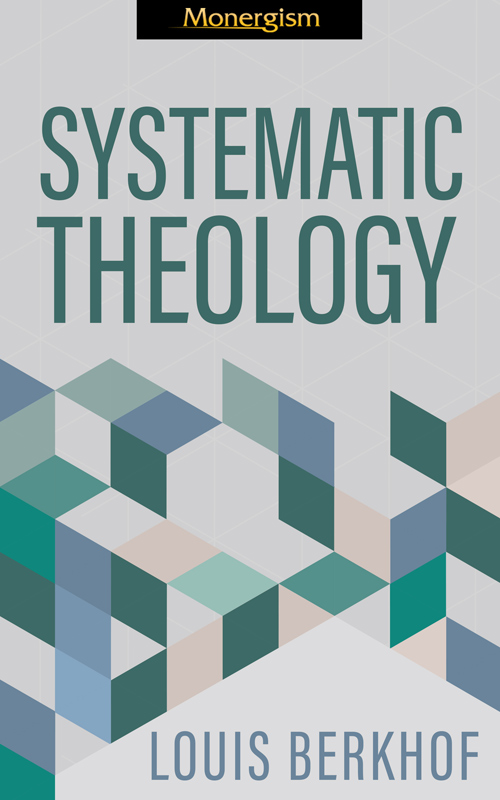 by Louis Berkhof
by Louis Berkhof
In ePub, .mobi and .pdf formats
You may also download the separate Introductory Volume to Systematic Theology here.
Professor Berkhof, who was the President of Calvin Seminary and professor of Systematic Theology at the same in the first half of the twentieth century, has given us an excellent compendium of Reformed theological thought in this hefty volume. The subject is treated in the classical style, moving through the Doctrines of God, Man in Relation to God, the Person and Work of Christ, the Application of the Work of Redemption, the Church and the Means of Grace, and the Last Things. For decades, Louis Berkhof’s Systematic Theology has remained one of the most important and widely-used systematic theologies. It provides the clearest and most succinct articulation of Reformed theology. From its first publication in 1932, Berkhof’s work was revised, reprinted, and translated into Chinese, Japanese, Korean, Spanish, and Portuguese, and it had become a standard theological text by 1950. It has gained near-universal use in seminaries and Bible colleges across the world, and is widely cited and used by pastors, theologians, and students of nearly all denominational affiliations.
His Systematic Theology was published in 1932 and revised in 1938. Wayne Grudem has said Berkhof’s Systematic Theology is “a great treasure-house of information and analysis . . . probably the most useful . . . systematic theology available from any theological perspective.” Richard Muller calls it “the best modern English-language introduction to doctrinal theology of the Reformed tradition.”
Berkhof’s loyalty to the well-defined lines of the Reformed Faith, his concise and compact style and his up-to-date treatment have made this work the most important twentieth century compendium of Reformed Theology. ‘The work seemed particularly important to me’, writes the author, ‘in view of the widespread doctrinal indifference of the present day, of the resulting superficiality and confusion in the minds of many professing Christians, of the insidious errors that are zealously propogated even from the pupits, and of the alarming increase of all kinds of sects. If there ever was a time when the Church ought to guard her precious heritage, the deposit of the truth that was entrusted to her acre, that time is now’.
-----
Table of Contents
PART ONE: THE DOCTRINE OF GOD
The Being of God
I. The Existence of God
II. The Knowability of God
III. Relation of the Being and Attributes of God
IV. The Names of God
V. The Attributes of God in General
VI. The Incommunicable Attributes
VII. The Communicable Attributes
VIII. The Holy Trinity
The Works of God
I. The Divine Decrees in General
II. Predestination
III. Creation in General
IV. Creation of the Spiritual World
V. Creation of the Material World
VI. Providence
PART TWO: THE DOCTRINE OF MAN IN RELATION TO GOD
Man in His Original State
I. The Origin of Man
II. The Constitutional Nature of Man
III. Man as the Image of God
IV. Man in the Covenant of Works
Man in the State of Sin
I. The Origin of Sin
II. The Essential Character of Sin
III. The Transmission of Sin
IV. Sin in the Life of the Human Race
V. The Punishment of Sin
Man in the Covenant of Grace
I. Name and Concept of the Covenant
II. The Covenant of Redemption
III. Nature of the Covenant of Grace
IV. The Dual Aspect of the Covenant
V. The Different Dispensations of the Covenant
PART THREE: THE DOCTRINE OF THE PERSON AND WORK OF CHRIST
The Person of Christ
I. The Doctrine of Christ in History
II. The Names and Natures of Christ
III. The Unipersonality of Christ
The States of Christ
I. The State of Humiliation
II. The State of Exaltation
The Offices of Christ
I. Introduction: The Prophetic Office
II. The Priestly Office
III. The Cause and Necessity of the Atonement
IV. The Nature of the Atonement
V. Divergent Theories of the Atonement
VI. The Purpose and Extent of the Atonement
VII. The Intercessory Work of Christ
VIII. The Kingly Office
PART FOUR: THE DOCTRINE OF THE APPLICATION OF THE WORK OF REDEMPTION
I. Soteriology in General
II. The Operation of the Holy Spirit in General
III. Common Grace
IV. The Mystical Union
V. Calling in General and External Calling
VI. Regeneration and Effectual Calling
VII. Conversion
VIII. Faith
IX. Justification
X. Sanctification
XI. Perseverance of the Saints
PART FIVE: THE DOCTRINE OF THE CHURCH AND OF THE MEANS OF GRACE
The Church
I. Scriptural Names of the Church and the Doctrine of the Church in History
II. Nature of the Church
III. The Government of the Church
IV. The Power of the Church
The Means of Grace
I. The Means of Grace in General
II. The Word as a Means of Grace
III. The Sacraments in General
IV. Christian Baptism
V. The Lord’s Supper
PART SIX: THE DOCTRINE OF THE LAST THINGS
Individual Eschatology
I. Introductory Chapter
II. Physical Death
III. The Immortality of the Soul
IV. The Intermediate State
General Eschatology
I. The Second Coming of Christ
II. Millennial Views
III. The Resurrection of the Dead
IV. The Final Judgment
V. The Final State
Bibliography
